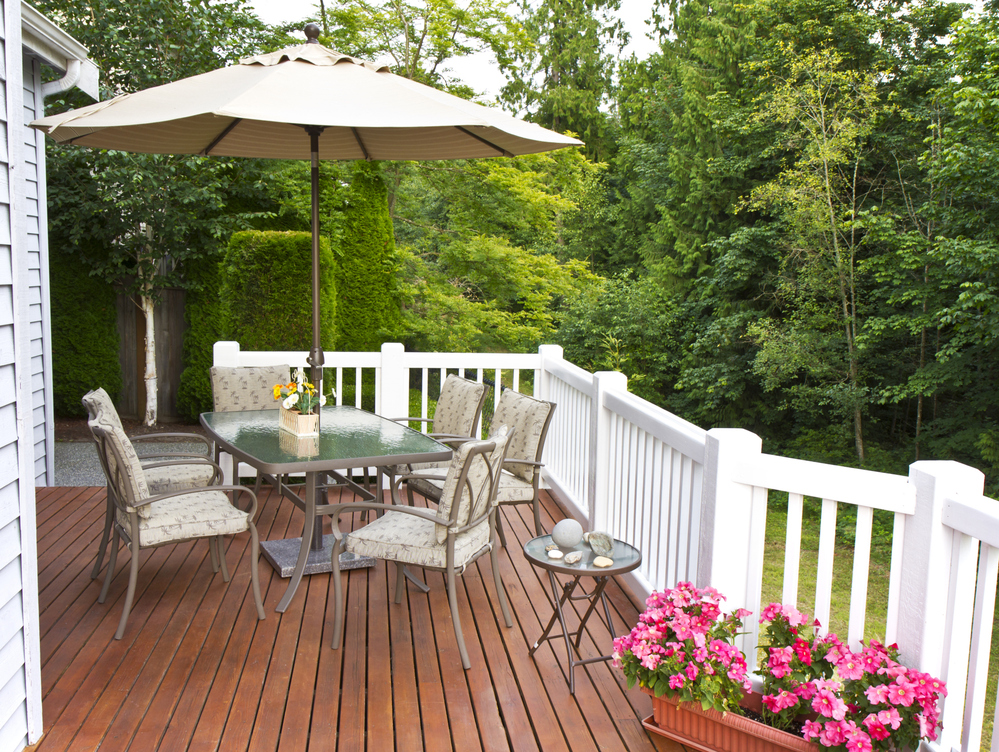Deck building can be a highly gratifying experience, from the thrill of the construction process to the joy of having a stunning finished product. A well-designed and expertly crafted deck has the power to extend your living area during the warmer months, creating a gathering place for family and friends and offering a much-needed space to relax and unwind.
However, it’s essential to be aware of common deck building mistakes that can dampen your enjoyment or compromise the safety of your deck. By steering clear of these pitfalls, you can ensure a smoother and more satisfying deck building journey.

Being Inattentive to Local Deck Building Code
Ensuring the structural integrity and adherence to building codes is non-negotiable when constructing decks. Building codes are typically based on the International Residential Code (IRC), with specific local amendments made to accommodate regional factors.
While it is essential to be familiar with the IRC requirements, many DIY builders tend to overlook the specific local changes. These amendments take into account factors such as the local climate and other unique needs of the area. Therefore, it is crucial to consult with your local permitting department to obtain accurate and up-to-date information regarding the deck-building code applicable to your location. By staying informed about the local regulations, you can guarantee that your deck is safe, meets all requirements, and provides a wonderful space for enjoyment and relaxation.
Building Inadequate Deck Post Footers
One end of the deck typically relies on a ledger board that attaches securely to the house. Ensuring a proper attachment of the deck ledger to the home is a crucial step in the deck building process and must be done in accordance with local building codes to ensure utmost safety. The other supporting points of the deck rest on the ground itself, known as on-grade. To bear the substantial weight of the deck, these on-grade vertical support posts must rest on solid and immovable footers. Avoid the following common deck footing mistakes:
- Undisturbed Soil: Footers should be placed in undisturbed soil. In cases where the soil has been previously disturbed, the footers must be installed at a greater depth, sometimes as deep as 48 inches, to provide sufficient stability.
- Frost Line: Footers must extend below the frost line specific to your region to prevent frost heave. At the very least, footers should extend 12 inches below the ground level.
- Elevation Above Grade: Elevate the tops of the footers at least an inch above the ground level to keep them elevated and protected from moisture.
Attaching the Beam to the Sides of the Support Posts
A common and potentially dangerous mistake during deck construction occurs when do-it-yourselfers attach the horizontal beam (also known as a girder) to the side of the vertical support posts. Although this method was previously allowed by building codes, it is now considered substandard because bolts used in this configuration can have poor shear strength, compromising the overall stability of the deck.
A far superior and safer approach, in alignment with most building codes, involves resting the beam on top of the support posts. This can be achieved by using metal column caps attached to the tops of the support posts or by notching out the support posts with a reciprocating saw to create a pocket where the beam can securely rest. Subsequently, attach the beam to the posts using galvanized carriage bolts, along with washers and nuts, to ensure a robust connection.
Incorrectly Spacing the Joists
In your home, the floor covering is supported by a subfloor, which is placed on long pieces of milled or laminate lumber known as joists. Similarly, your outdoor deck follows a similar principle, except without the subfloor; the deck floorboards are directly fastened onto the joists. As a result, the deck boards carry the entire load without the intermediate support of a subfloor.
It’s important to note that composite and PVC deck boards, in particular, may not have the same structural strength as most woods, especially hardwoods. Consequently, they may require tighter joist spacing for added support. To determine the appropriate joist spacing for the type of deck flooring you plan to install, refer to joist span tables specific to that material.
Installing the Wrong Deck Boards for Your Use
When choosing deck floorboards, you’ll find a wide range of options available, ranging from cost-effective pressure-treated boards to luxurious exotic hardwoods and composite woods. To make the best choice for your specific needs, it’s essential to assess your personal situation and consider various factors before purchasing deck boards.
For those on a tight budget or building a deck for quick resale, cost-effective options like pressure-treated or hem-fir (hemlock-fir combination) boards may be suitable. These materials offer an affordable solution while still providing a functional and appealing deck.
On the other hand, high-end homes may call for premium exotic hardwoods like ipe. These exquisite materials not only offer exceptional durability but also add a touch of luxury and elegance to the overall design.
If durability and low maintenance are your top priorities, composite woods and PVC-based materials are excellent choices. These materials provide a long-lasting, low-maintenance solution, making them a valuable investment for the long term.
Attaching the Ledger Board Directly to the Siding
The ledger board plays a vital role in the structural integrity of the deck as it serves as the backbone, securely anchoring the deck to the most stable surface available – the house. However, some do-it-yourselfers mistakenly attach the ledger board on top of the siding.
This approach is problematic because the layers of siding and potentially exterior rigid foam insulation hinder the lag screws from penetrating deep enough into the rim joist, compromising the deck’s stability. To ensure the ledger board is properly attached, it is essential to follow the correct method. This involves carefully cutting out all siding, house wrap or tar paper, and foam insulation to create a direct connection, allowing the ledger board to rest firmly on the rim joist.
Blocking Egress and Access to Services
When constructing a deck attached to the side of your house, it’s crucial to consider the potential impact on various utilities and services. Deck installation may inadvertently cover or obstruct water faucets, dryer vents, air conditioning units, and exterior outlets. To avoid these issues, it’s essential to relocate any services that might be affected by the new deck.
Additionally, take into account the egress from a basement window. In some cases, your deck permit might not be approved by the local permitting department if the deck hinders access to a basement window, which is vital for emergency exits.
Not Using Corrosive Resistant Fasteners
The choice of fasteners for your deck is critical to its overall stability and longevity. Decks are exposed to harsh outdoor conditions, enduring significant wear and tear from the elements. Using the wrong type of fasteners can lead to catastrophic consequences. Moreover, certain fasteners may react with the wood preservatives, accelerating corrosion and compromising the deck’s structural integrity.
To ensure the best performance, it is essential to purchase fasteners specifically approved for deck-building purposes. Typically, these approved fasteners are made from stainless steel, polymer-coated materials, or hot-dipped galvanized materials. These options offer excellent resistance to corrosion and provide the necessary strength to withstand outdoor conditions over time.
Not Installing Handrails on Low-Rise Decks
Constructing a low-rise deck that is under 30 inches tall has the advantage of potentially not requiring handrails under various local building codes. This exemption from handrails can save both time and money while preserving the unobstructed view from the deck. However, it is essential to consider the safety implications of this decision.
Although the height may be under 30 inches, accidents can still happen, and a fall from such a height can result in injuries. Many experienced deck builders choose to include handrails, even when not mandated by the code, precisely for this reason – to enhance safety and prevent accidents.
Prioritizing safety should always be a top concern when building a deck. Handrails provide an added layer of protection, especially for families with children or elderly individuals who may be more susceptible to falls. It is worth considering the value of handrails in promoting safety and peace of mind for those using the deck.
Not Immediately Applying Waterproof Coating
Wood used in decks starts to weather and deteriorate soon after installation due to exposure to the elements. While it may be tempting to postpone the application of waterproof coating, it is crucial to act promptly. Applying the waterproof coating as soon as possible is highly recommended.
Newly installed wood is in its prime condition for receiving coatings effectively. The wood’s surface is relatively clean and free from dirt, grime, and other contaminants that accumulate over time. Sealing the wood early on helps to protect it from moisture, UV rays, and other environmental factors that contribute to its weathering.
Adding Too Many Extras
Before finalizing your deck plans, carefully assess your preferred outdoor activities to determine if the proposed deck design aligns with your needs. Some deck company sales representatives may push for numerous extras, such as benches, built-in features, lights, and awnings. However, it’s essential to consider whether these extras are genuinely necessary for your lifestyle and intended use of the deck.
Ask yourself practical questions about the potential extras: Will you use the benches regularly? Are built-ins essential for your outdoor gatherings? Do you require additional lighting? Is an awning necessary for shade and protection?
By evaluating your actual needs and preferences, you can avoid overspending on unnecessary features and focus on creating a deck that complements your outdoor lifestyle.
Not Seeking Professional Deck-Building Help
Starting a deck-building project with a do-it-yourself mindset is a common approach among homeowners. However, some may encounter challenges along the way that can lead to the project stalling for months. Before embarking on such a venture solo, it’s crucial to fully understand the complexities of deck-building and honestly evaluate whether you have the necessary skills and expertise for the job. If not, seeking the help of a local licensed general contractor or experienced deck builder is a wise decision.
Building a deck involves various technical aspects, including structural integrity, proper measurements, and compliance with local building codes. Without the right knowledge and experience, mistakes can lead to safety hazards or costly rework. Professional contractors have the expertise to handle these intricacies efficiently, ensuring a successful and safe deck-building project.
While taking on a DIY deck project can be rewarding, it’s essential to be realistic about your abilities and the scope of the project. Enlisting the help of qualified professionals will not only save time and effort but also provide peace of mind, knowing that your deck will be constructed with precision and to the highest standards.













Leave a Reply